Archaic Period - 800-480 B.C.
There is some debate regarding where the world's first true coin came from, but most experts agree that the appearance of the first coins were in the Ioinan and Lydian regions of Anatolia’s Aegean shore in Asia Minor, or present-day Turkey. Even though there were well established civilizations like Egypt and Mesopotamia long before that, it wasn't until the 7th Century, B.C. that coins made their first appearance.
The first coins were actually ingots of electrum, a naturally occurring alloy of silver and gold, that was found in the area. At some point in 650 B.C. a system of standarized weights devloped so that the purity and weight could be established with each transaction. These ingots of electrum were stamped by governmental authorities in Lydia and surrounding areas as they began adopting the practice of unifying coins. Coins evolved and flourished in the area and became the standard currency for trade.
An Example of The World's First Coin
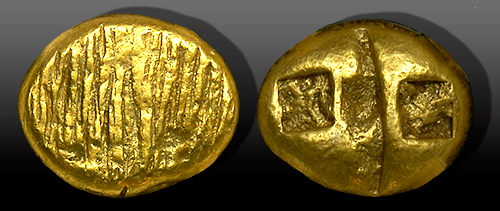

Uncertain Mint, Ionia, c. 650 - 600 B.C. - This very primitive looking coin is an example of the first true coinage, issued around 650 B.C. in Ionia, or modern day Turkey. While it appears to be gold, it is actually comprised of electrum, a natural alloy of gold and silver, called "white gold" in ancient times. The lines on the obverse that look like scratches are actually thought to have represented flowing water. The reverse employs an incuse double-punch created with a hammer during the minting process.
As lumps of electrum developed into the first gold and silver coins issued by Croesus the King of Lydia from 560-547 B.C., old systems of barter fell to the wayside. King Croesus became the first leader to establish a bimetallic, interrelated coinage system. Coins became remarkably successful and spread quickly from east to west.
An Example of Lydia (Croesus or later) Gold Stater
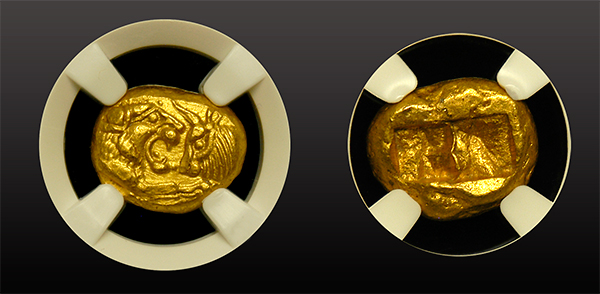

Struck during the time of King Croesus, the obverse employs a lion and bull, thought to symbolize life and fertility. The luster and overall appearance is incredible. It is hard to believe that this magnificent Gold Stater was struck over 2,500 years ago.
The Classic Period - 500-323 B.C.
As the popularity of coins increased, so did the amount of attention to detail and elaborate artistic designs to both sides of the coins. The incuse punch became stylized with plants and animals which soon developed into portraits of their patron god or goddess, or a legendary hero. On the other side it was common to use a symbol of their city.
A classic style developed through the period of 500 to 330 B.C., however, the Classical period lacked a true boundary and is said to have begun and ended at different times in different places. What is most important to note was the attention to detail that were often crafted by master artists who often signed their dies.
Classical Greek Style - Attica Athenian Owl
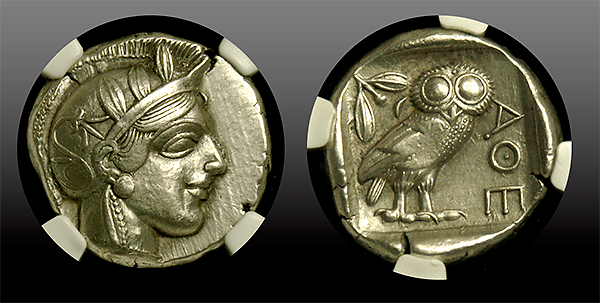

In 479 B.C., the Persian army was defeated at Plataea by the alliance of Greek states. Athens emerged as the dominant military and economic power.
The Athenian Tetradrachms are some of the most well-known of all ancient coinage. Called “Athenian Owls”, in reference to the lifelike owl depicted on the reverse, these 2,500 year old coins were an integral part of Greek commerce after winning the Persian wars. Athena, the Goddess of Wisdom, is pictured on the obverse in standard portrait fashion.
Classical Greek Style
Corinthia, Corinth- Silver- Stater- Obverse Pegasus & Reverse Helmeted Athena
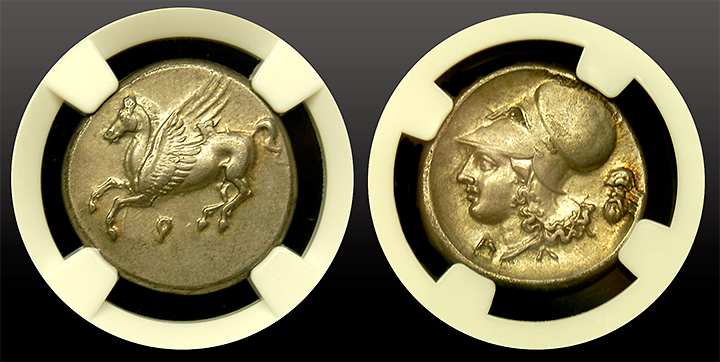

This is the time when really exquisite artistic styles were being issued in coins, designed by master artists who often signed their dies. The obverse depicts Pegasus in flight and the reverse a helmeted Athena, the Goddess of War.
Hellenistic Period - 323-146 B.C.
Some historians believe that the Hellenistic period started with Philip II, but it truly started after the death of Alexander the Great [323 B.C.]. After Alexander's death his former kingdom was divided up among five of Alexander’s generals. A struggle for power resulted in the establishment of three main kingdoms of Egypt, Asia Minor, and Macedonia. Even though the empire was splitting,Greek civilization continued to spread throughout the region. A new order of both power and numismatics evolved characterized by the spread of Greek culture across a large part of the known world.
Greek culture spread far into areas like Egypt and a new period of Hellenistic coins featuring portraits of living people, namely of the kings or pharaohs themselves. Even though coins featuring portraits of leaders had started in Greece, most Greeks thought the practice was quite arrogant. This wasn't a source of contention with the kings of Ptolemaic Egypt, which had already risen to the level of "divine" status. Issuing magnificent gold coins adorned with their own portraits and portraits of their dynasties became commonplace and lasted for hundreds of years.
"All Greek coins were handmade, rather than machined as modern coins are. The design for the obverse was carved (in incuso) into a block of bronze or possibly iron, called a die. The design of the reverse was carved into a similar punch. A blank disk of gold, silver, or electrum was cast in a mold and then, placed between these two and the punch struck hard with a hammer, raising the design on both sides of the coin." [1]
Hellenistic Style - Arsinoe II Gold Octodrachm
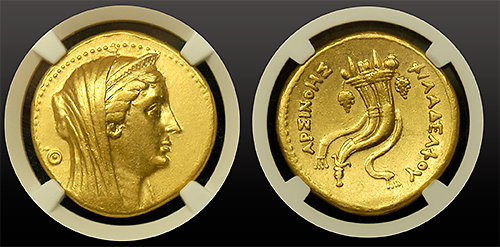

Larger and heavier than most Greek gold coins, this was struck in Egypt to honor Arsinoe II, sister and wife of Ptolemy II of Egypt. The Ptolemaic Dynasty ruled Egypt for nearly three centuries following the death of Alexander the Great, when Ptolemy, one of Alexander's generals, established control over the area.
Hellenistic Style - Ptolemy III Gold Octodrachm
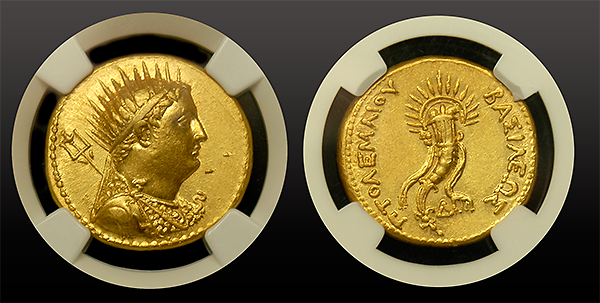

Ptolemaic Kingdom - Ptolemy III Gold Octodrachm - The grandson of the general Ptolemy I. Ptolemy I served under Alexander the Great, and after Alexander's death when the empire was broken up Ptolemy I established control over Egypt. This gold coin depicting Ptolemy III was issued by Ptolemy IV to honor his deified father.
Hellenistic Style - Kingdom of Thrace, Lysimachus, Silver Tetradrachm
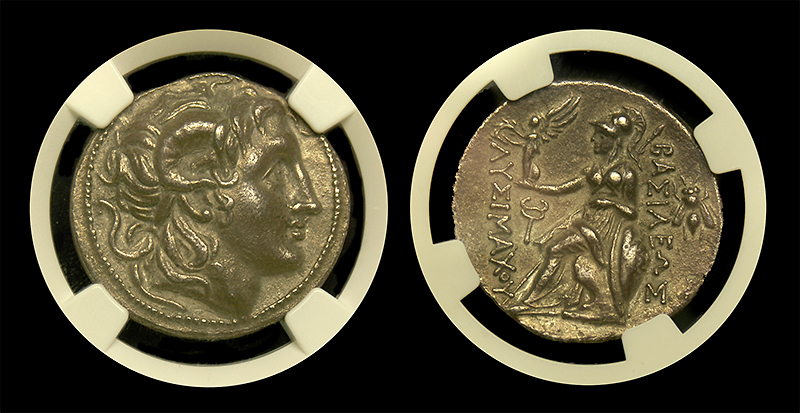
This large Silver Tetradrachm was issued during the 1st Mithridatic War—a clash between the Greek cities and the Roman Republic. The obverse pays tribute to Alexander the Great with a portrait thought to resemble him while the back depicts Athena, the Goddess of War.
Post-Hellenistic Period - 146-30 B.C.
"In the 2nd to 1st centuries BC, Rome conquered Greece piece by piece until, with the conquest of Egypt in 30 BC, the Roman Empire controlled the Mediterranean. Roman art and literature were imposed upon Hellenistic models. Greek remained the dominant language in the eastern part of the Roman Empire. In the city of Rome, Greek was in widespread use among ordinary people, and the elite spoke and wrote Greek as fluently as Latin." [2]
https://www.youtube.com/watch?v=324a8_E15rc
https://www.youtube.com/watch?v=324a8_E15rc

0 Comments